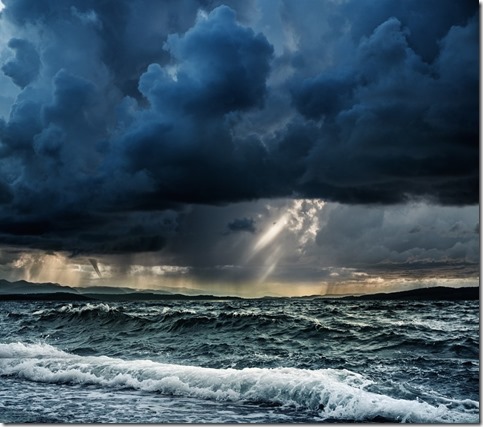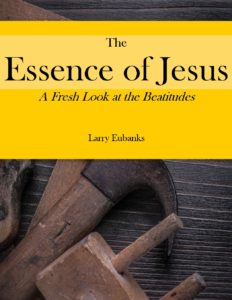
Brooding Spirit of Creation
 Theologians like to use sophisticated words like “transcendence” and “immanence” when talking about the fact that God is outside of the world yet continually active in it. The ancient Jewish writers of Scripture, however, talked about the same things by painting word pictures.
Theologians like to use sophisticated words like “transcendence” and “immanence” when talking about the fact that God is outside of the world yet continually active in it. The ancient Jewish writers of Scripture, however, talked about the same things by painting word pictures.
Word pictures are much cooler than sophisticated words.
Much cooler.
The first word picture we encounter is in Genesis 1:2—“Now the earth was formless and empty, and darkness covered the face of the deep, and the wind/spirit of God brooded over the face of the waters.”
You will notice that it looks like I can’t make up my mind how to translate one of those words. Is it wind or is it spirit? Usually translators pick one or the other, most using “spirit.” I think both senses are intended here.
In the first sense we have the image of a wild, fierce wind blowing over the face of a wild, fierce ocean of water.
We need air to live, and we need the air to move in order to live, but the movement of that air can bring destruction as well as refreshment.
A cool breeze is a welcome break from the heat; a tornado can drop suddenly from the sky and destroy whole towns.
Wind brings life; wind kills. The two abide together, and we must accept both.
Similarly, water is both necessary to life and a danger to it. You can drink it and live, or you can drown in it and die.
The first humans lived near streams, lakes, and rivers, yet suffered through dangerous and damaging floods. Efforts to tame water to use it are fraught with danger, because dams burst and levees are breached.
Water gives life; water kills. The two abide together, and we must accept both
So this wind/spirit life/death force blows over the face of the waters, the other life/death force. Before life can appear, it must be contained and controlled, and that is what happens.
The firmament is created to separate the waters above from those below. Then the waters on the earth are gathered together so that dry land can appear.
But the life/death tension still exists; chaos lurks in the deep, ready to reassert itself.
What of the wind, how is it controlled? We are a told it blows over the face of the waters. The sense of the Hebrew word is that it was hovering, which is stationary movement—a paradoxical tension.
The word translated here is rarely used in the Bible, but one of those places is Deuteronomy 32:11—“As an eagle stirs up its nest, and hovers over its young; as it spreads its wings, takes them up, and bears them aloft on its pinions….”
This is why I used the word “brood” in my translation, not in the sense of pondering something but rather of a mother bird taking care of its young, setting on the eggs to keep them warm and protected until they hatch, then watching over them while they are young and vulnerable.
This is where the other sense of wind/spirit comes into play, for it is the spirit of God that broods over creation, pushing and containing the life/death forces so that life can emerge.
Keeping chaos at bay so that life can flourish.
This is how we experience life, is it not? Our lives are full of the tension between life and death, order and chaos. The moment we are born we begin our march toward death, and it is in death that life is renewed.
The food for every living thing is something that once was alive, whether it be animal, fruit or vegetable. Two things seemingly at odds are actually wrapped up in each other.
Death is not an intrusion into life but rather integral to it. There is no life without death, nor death without life.
We spend our lives trying to create order out of chaos. Sometimes our lives seem very ordered—everything is running smoothly, there is peace, there is contentment, there is satisfaction.
Sometimes it seems that the dam has broken and our lives are complete chaos.
These two extremes are actually kind of rare; most of the time we are somewhere in between.
Through it all there is the Spirit of God hovering, brooding, caring, protecting. She brings order to our lives, and on those occasions when the chaos breaks through, she is the wind who blows in to contain the waters of chaos.
Photo by © Can Stock Photo Inc. / Nejron
 I am a lifelong student of the Bible, and have been a pastor for over twenty-five years. My desire through this blog is to help people see things in the intersection of Scripture and real life that they might have missed. The careless handling of the Bible is causing a lot of problems in our churches and our culture--and is literally turning people away from the church, and, sometimes, God. I hope to treat Scripture with the respect it deserves, and, even if you don't agree with what I say, give you some insight.
Feel free to leave a comment. I promise to respond to you. All I ask is that you be respectful in your comments.
I am a lifelong student of the Bible, and have been a pastor for over twenty-five years. My desire through this blog is to help people see things in the intersection of Scripture and real life that they might have missed. The careless handling of the Bible is causing a lot of problems in our churches and our culture--and is literally turning people away from the church, and, sometimes, God. I hope to treat Scripture with the respect it deserves, and, even if you don't agree with what I say, give you some insight.
Feel free to leave a comment. I promise to respond to you. All I ask is that you be respectful in your comments. 
Connect with Me